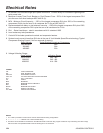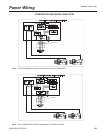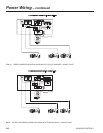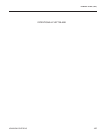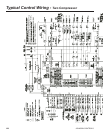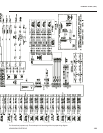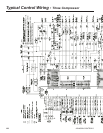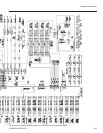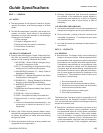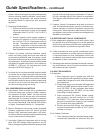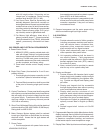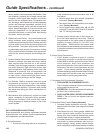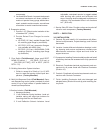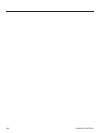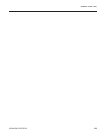
JOHNSON CONTROLS132
UNIT LOCATION
The YCIV chillers are designed for outdoor installation.
When selecting a site for installation, be guided by the
following requirements:
1. Installation sites may be either on a roof or on ground
level. (See FOUNDATION)
2. Select a place having an adequate supply of fresh air
for the condensers. Recommended clearances for all
units are shown on the DIMENSIONS pages.
3. Avoid locations near windows or structures where
normal operating sounds may be objectionable.
4. The standard condenser fans are propeller-type and
are not recommended for use with ductwork, lters
or other impedements to airow in the condenser air
stream.
5. When it is desirable to surround the unit(s), it is rec-
ommended that the screening be able to pass the
required chiller CFM without exceeding 0.1" external
static pressure.
6. Protection against corrosive environments is available
by supplying the units with either copper ns, or cured
epoxy-coating on the condenser coils. Epoxy-coated
coils should be utilized with any units being installed at
the seashore, or where salt spray may hit the units, or
where acid rain is prevalent (copper condenser coils
are not recommended where they may be exposed
to acid rain).
7. On installations where winter operation is intended and
snow accumulations are expected, additional eleva-
tion must be provided to insure normal condenser air
ow.
FOUNDATION
The unit should be mounted on a at and level founda-
tion, ground or roof, capable of supporting the entire
operating weight of the equipment. Please contact your
nearest Johnson Controls Sales Ofce for shipping and
operating weights.
Roof Locations – Adequate structural strength to safely
support the entire weight of the unit and service person-
nel must be provided. Care must be taken not to damage
the roof during installation. If the roof is “bonded”, consult
building contractor or architect for special installation re-
quirements. Roof installations should incorporate the use
of spring-type isolators to minimize the transmission of
vibration into building structure. Additional support should
be provided to the roof at the spring-isolator locations.
Ground Locations – Units must be installed on a sub-
stantial base that will not settle and cause strain on the
refrigerant lines, resulting in possible leaks. A one-piece
concrete slab, with footers extending below the frost line,
is recommended. The slab should not be tied to the main
building foundation as noises will telegraph.
Mounting holes (5/8") are provided in the base rails for
bolting the unit to its foundation. See DIMENSIONS for
location of the mounting holes.
For ground installations, precautions should be taken to
protect the unit from tampering by, or injury to, unauthor-
ized persons. Fasteners on access panels will prevent
casual tampering; however, further safety precautions,
such as unit enclosure options, a fenced-in enclosure, or
locking devices on the panels may be advisable. Check
local authorities for safety regulations.
CHILLED LIQUID PIPING
The chilled liquid piping system should be laid out so that
the circulating pump discharges into the cooler. The inlet
and outlet cooler-liquid connections are given in DIMEN-
SIONS. Hand stop valves are recommended for use in
all lines to facilitate servicing. Drain connections should
be provided at all low points to permit complete drainage
of the cooler and system piping.
A strainer (40 mesh) is recommended for use on the INLET
line to the cooler, and must be in place at initial operation
of the water pumps.
Pressure-gauge connections are recommended for instal-
lation in the inlet and outlet water lines. Gauges are not
provided with the unit and are to be furnished by others.
Chilled liquid lines exposed to the weather should be
wrapped with a supplemental heater cable and insulated,
or glycol should be added to the chilled liquid to protect
against freezing if low-ambient periods are expected.
A ow switch is available as an accessory on all units. A
ow switch must be installed in the leaving water piping
of the cooler and must not be used to start and stop the
unit.
Application Data



